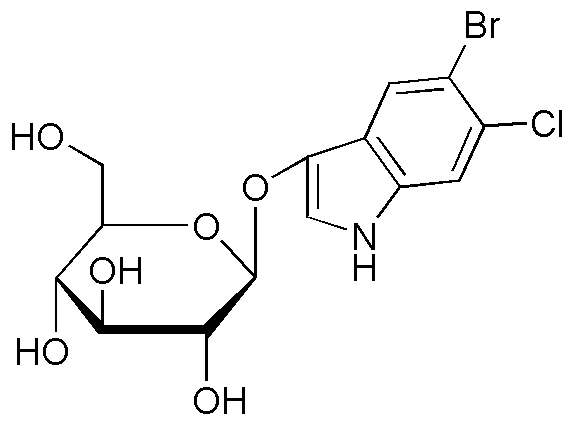5-Bromo-6-chloro-3-indoxyl-b-D-glucopyranoside is widely utilized in research focused on:
- Biochemical Assays: This compound serves as a substrate in enzyme assays, particularly for detecting β-glucosidase activity, which is crucial in various biochemical research applications.
- Histochemical Staining: It is employed in histochemistry for visualizing specific enzyme activities in tissue samples, aiding in the study of cellular processes and disease mechanisms.
- Plant Research: Used in plant biology, it helps in studying gene expression related to glucoside metabolism, providing insights into plant physiology and development.
- Pharmaceutical Development: This compound can be a part of drug formulation research, particularly in developing targeted therapies that utilize enzyme interactions for improved efficacy.
- Biotechnology Applications: It is valuable in genetic engineering, where it can be used to track the expression of transgenes in modified organisms, enhancing the understanding of genetic modifications.
General Information
Properties
Safety and Regulations
Applications
5-Bromo-6-chloro-3-indoxyl-b-D-glucopyranoside is widely utilized in research focused on:
- Biochemical Assays: This compound serves as a substrate in enzyme assays, particularly for detecting β-glucosidase activity, which is crucial in various biochemical research applications.
- Histochemical Staining: It is employed in histochemistry for visualizing specific enzyme activities in tissue samples, aiding in the study of cellular processes and disease mechanisms.
- Plant Research: Used in plant biology, it helps in studying gene expression related to glucoside metabolism, providing insights into plant physiology and development.
- Pharmaceutical Development: This compound can be a part of drug formulation research, particularly in developing targeted therapies that utilize enzyme interactions for improved efficacy.
- Biotechnology Applications: It is valuable in genetic engineering, where it can be used to track the expression of transgenes in modified organisms, enhancing the understanding of genetic modifications.
Documents
Safety Data Sheets (SDS)
The SDS provides comprehensive safety information on handling, storage, and disposal of the product.
Product Specification (PS)
The PS provides a comprehensive breakdown of the product’s properties, including chemical composition, physical state, purity, and storage requirements. It also details acceptable quality ranges and the product's intended applications.
Certificates of Analysis (COA)
Search for Certificates of Analysis (COA) by entering the products Lot Number. Lot and Batch Numbers can be found on a product’s label following the words ‘Lot’ or ‘Batch’.
*Catalog Number
*Lot Number
Certificates Of Origin (COO)
This COO confirms the country where the product was manufactured, and also details the materials and components used in it and whether it is derived from natural, synthetic, or other specific sources. This certificate may be required for customs, trade, and regulatory compliance.
*Catalog Number
*Lot Number
Safety Data Sheets (SDS)
The SDS provides comprehensive safety information on handling, storage, and disposal of the product.
DownloadProduct Specification (PS)
The PS provides a comprehensive breakdown of the product’s properties, including chemical composition, physical state, purity, and storage requirements. It also details acceptable quality ranges and the product's intended applications.
DownloadCertificates of Analysis (COA)
Search for Certificates of Analysis (COA) by entering the products Lot Number. Lot and Batch Numbers can be found on a product’s label following the words ‘Lot’ or ‘Batch’.
*Catalog Number
*Lot Number
Certificates Of Origin (COO)
This COO confirms the country where the product was manufactured, and also details the materials and components used in it and whether it is derived from natural, synthetic, or other specific sources. This certificate may be required for customs, trade, and regulatory compliance.


